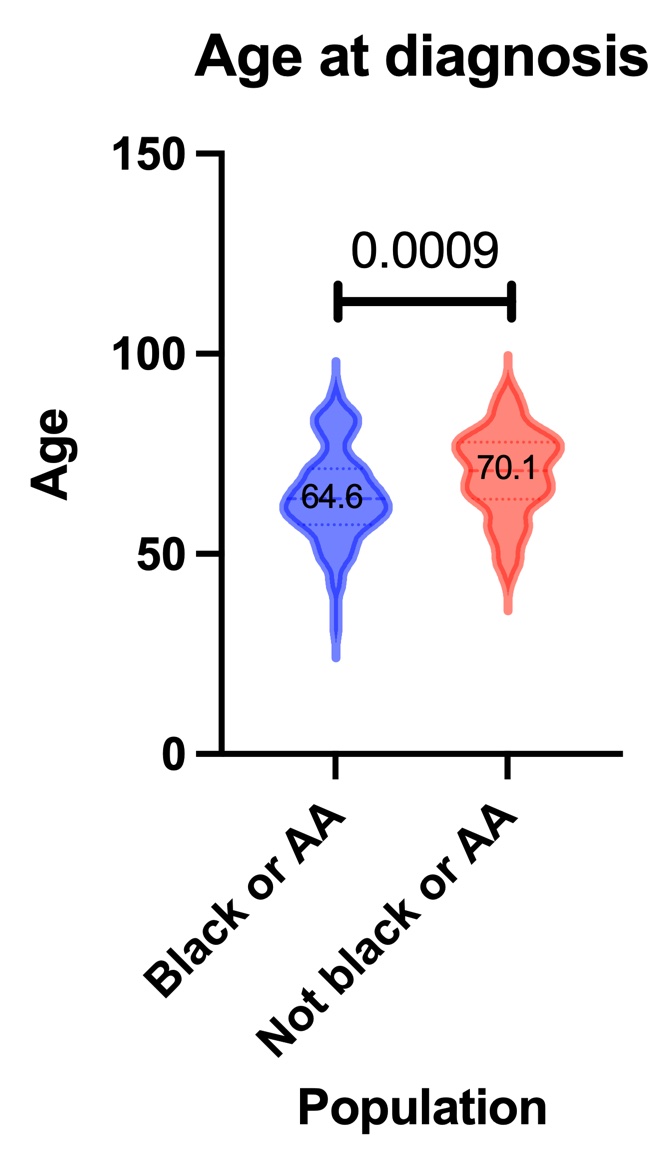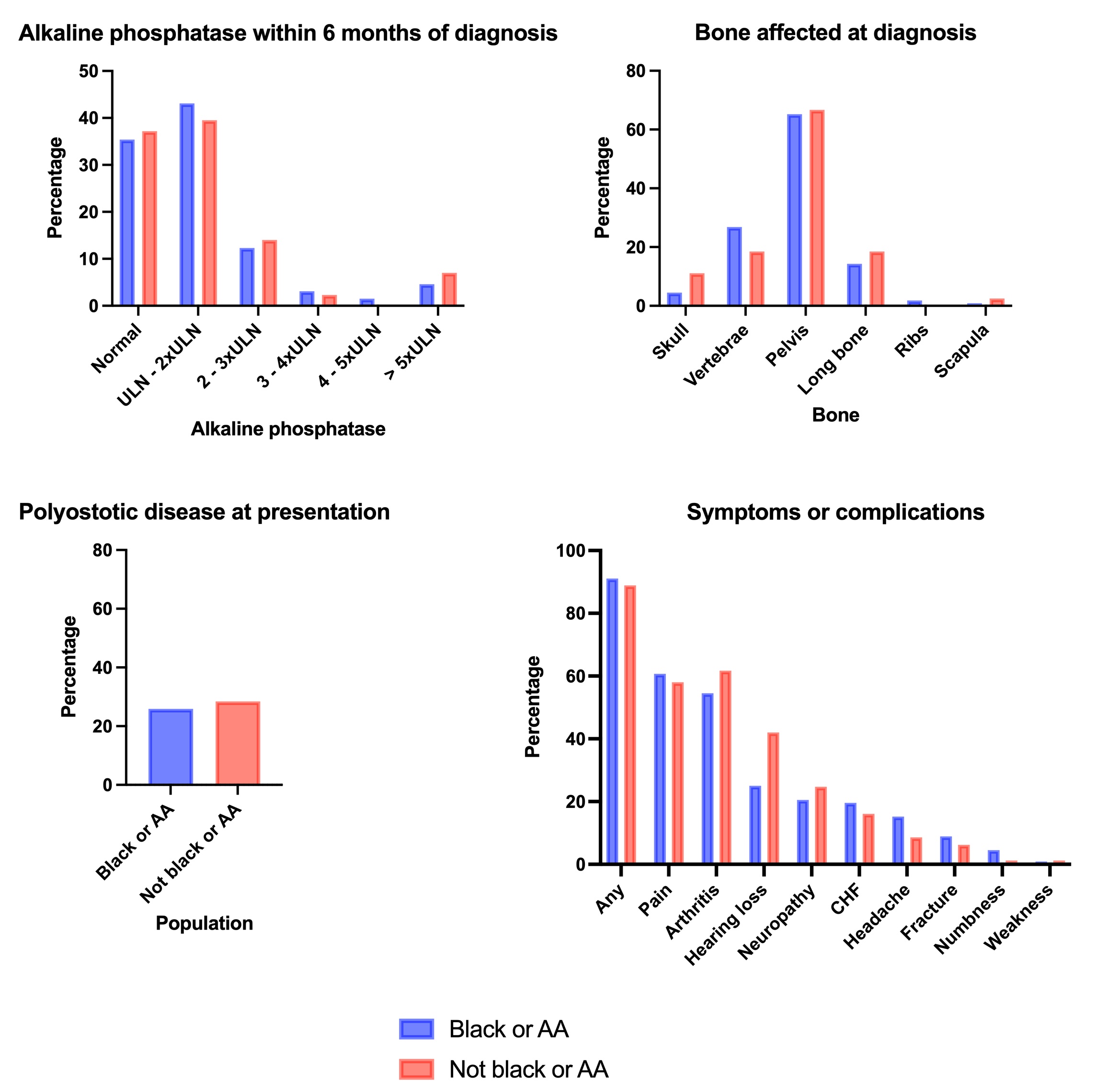Back
Poster Session C
Metabolic bone disease
Session: (1304–1331) Osteoporosis and Metabolic Bone Disease – Basic and Clinical Science Poster
1316: A Cluster of Paget Disease of the Bone in Black or African American Patients in a Veteran Population
Sunday, November 13, 2022
1:00 PM – 3:00 PM Eastern Time
Location: Virtual Poster Hall
- MU
Mariana Urquiaga, MD
University of Alabama at Birmingham
Birmingham, AL, United States
Abstract Poster Presenter(s)
Mariana Urquiaga and Angelo Gaffo, University of Alabama at Birmingham, Birmingham, AL
Background/Purpose: Genetic and environmental factors have been implicated in the pathogenesis of Paget Disease of the Bone (PDB). Although the disease is described more frequently among patients of northern European descent, our own clinical observations challenged that description. Our primary goal was to evaluate if the proportion of black or African American patients diagnosed with PDB was higher than the proportion of white patients with the same diagnosis. As a secondary goal, we evaluated differences in the clinical presentation between black or African American patients and patients of other races.
Methods: We conducted a retrospective observational study using the Veterans Affairs Clinical Data Warehouse (CDW). We performed a query for all patients with an ICD-9 or 10 code for PDB or osteitis deformans between January 2000 and December 2020. We extracted the registered race and compared the proportion of black or African American patients to white patients among those seen at our local VA medical center and those at a national level.
We reviewed the electronic medical record among the patients seen at the BVAMC who had imaging confirmation of PDB. We extracted clinical variables such as the age at diagnosis, alkaline phosphatase level at the time of diagnosis, affected bone(s), and associated symptoms and complications.
Results: We identified 285 individuals seen at our local VA medical center for PDB during the study period. The proportion of black or African American patients was significantly higher than white patients (Figure 1). This was the opposite to the results among patients with PDB at a national VA level. Among the patients with imaging confirmation of PDB seen at our VA medical center (n=193), Black or African American patients presented at a younger age than their peers but did not have higher alkaline phosphatase levels, a higher proportion of polyostotic disease, or a higher rate of symptoms and complications (Figure 2 and 3).
Conclusion: Our findings confirm a much higher frequency of diagnosis of PDB among African Americans at our local VA medical center than in the general VA population. This was not explained by the ethnic/racial distribution of the population as a whole, suggesting the presence of a cluster of disease among African Americans. The presence of this cluster supports existing evidence that environmental factors are likely crucial to the pathogenesis of the disease and that there could be an undiscovered genetic predisposition.
.jpg) Graph showing the distribution of race among patients with PDB, based on ICD codes and imaging confirmation, at our local VA Medical Center and nationally, next to the distribution of race of veterans in our state overall.
Graph showing the distribution of race among patients with PDB, based on ICD codes and imaging confirmation, at our local VA Medical Center and nationally, next to the distribution of race of veterans in our state overall.
 Age at diagnosis of PDB among our local VA Medical Center patients
Age at diagnosis of PDB among our local VA Medical Center patients
 Symptoms and complications among patients with imaging confirmed PDB
Symptoms and complications among patients with imaging confirmed PDB
Disclosures: M. Urquiaga, None; A. Gaffo, None.
Background/Purpose: Genetic and environmental factors have been implicated in the pathogenesis of Paget Disease of the Bone (PDB). Although the disease is described more frequently among patients of northern European descent, our own clinical observations challenged that description. Our primary goal was to evaluate if the proportion of black or African American patients diagnosed with PDB was higher than the proportion of white patients with the same diagnosis. As a secondary goal, we evaluated differences in the clinical presentation between black or African American patients and patients of other races.
Methods: We conducted a retrospective observational study using the Veterans Affairs Clinical Data Warehouse (CDW). We performed a query for all patients with an ICD-9 or 10 code for PDB or osteitis deformans between January 2000 and December 2020. We extracted the registered race and compared the proportion of black or African American patients to white patients among those seen at our local VA medical center and those at a national level.
We reviewed the electronic medical record among the patients seen at the BVAMC who had imaging confirmation of PDB. We extracted clinical variables such as the age at diagnosis, alkaline phosphatase level at the time of diagnosis, affected bone(s), and associated symptoms and complications.
Results: We identified 285 individuals seen at our local VA medical center for PDB during the study period. The proportion of black or African American patients was significantly higher than white patients (Figure 1). This was the opposite to the results among patients with PDB at a national VA level. Among the patients with imaging confirmation of PDB seen at our VA medical center (n=193), Black or African American patients presented at a younger age than their peers but did not have higher alkaline phosphatase levels, a higher proportion of polyostotic disease, or a higher rate of symptoms and complications (Figure 2 and 3).
Conclusion: Our findings confirm a much higher frequency of diagnosis of PDB among African Americans at our local VA medical center than in the general VA population. This was not explained by the ethnic/racial distribution of the population as a whole, suggesting the presence of a cluster of disease among African Americans. The presence of this cluster supports existing evidence that environmental factors are likely crucial to the pathogenesis of the disease and that there could be an undiscovered genetic predisposition.
.jpg) Graph showing the distribution of race among patients with PDB, based on ICD codes and imaging confirmation, at our local VA Medical Center and nationally, next to the distribution of race of veterans in our state overall.
Graph showing the distribution of race among patients with PDB, based on ICD codes and imaging confirmation, at our local VA Medical Center and nationally, next to the distribution of race of veterans in our state overall.  Age at diagnosis of PDB among our local VA Medical Center patients
Age at diagnosis of PDB among our local VA Medical Center patients Symptoms and complications among patients with imaging confirmed PDB
Symptoms and complications among patients with imaging confirmed PDBDisclosures: M. Urquiaga, None; A. Gaffo, None.

